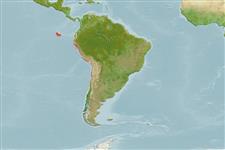Teleostei (teleosts) >
Gobiesociformes (Clingfishes) >
Gobiesocidae (Clingfishes and singleslits) > Gobiesocinae
Etymology: Tomicodon: Greek, tomikos, -e, -on = that is useful for cutting (Ref. 45335).
Environment: milieu / climate zone / depth range / distribution range
Ecology
Marine; demersal. Subtropical
Eastern Pacific: Lobos de Afuera, Peru to Valparaiso, Chile, including the Galapagos Islands.
Size / Weight / Age
Maturity: Lm ? range ? - ? cm
Max length : 5.0 cm TL male/unsexed; (Ref. 28023)
Short description
Identification keys | Morphology | Morphometrics
Dorsal spines (total): 0; Dorsal soft rays (total): 7 - 9; Anal spines: 0; Anal soft rays: 6 - 9. Pale with numerous small, dark-gray and black spots and vermiculations on sides; no markings on venter; prominent black spot just above pectoral fin base; fins dusky, the margins transparent. Equal numbers of teeth in each jaw, the canines strong and longer than the four pairs of incisors; middle pair of incisors smooth-edged, the outer ones trifid; posterior nostril in front of anterior margin of orbit; gill membrane attached opposite upper edge of pectoral fin; anus closer to anal-fin origin than to rear margin of disc.
Facultative air-breathing in the genus (Ref. 126274); Occurs along shallow coastal shores, where it probably clings to rocks of the substratum.
Life cycle and mating behavior
Maturity | Reproduction | Spawning | Eggs | Fecundity | Larvae
Grove, J.S. and R.J. Lavenberg, 1997. The fishes of the Galápagos Islands. Stanford University Press, Stanford, 863 p. (Ref. 28023)
IUCN Red List Status (Ref. 130435: Version 2024-2)
Threat to humans
Harmless
Human uses
Tools
Special reports
Download XML
Internet sources
Estimates based on models
Preferred temperature (Ref.
123201): 18.1 - 23.7, mean 20.3 °C (based on 102 cells).
Phylogenetic diversity index (Ref.
82804): PD
50 = 0.5000 [Uniqueness, from 0.5 = low to 2.0 = high].
Bayesian length-weight: a=0.00617 (0.00250 - 0.01521), b=3.15 (2.94 - 3.36), in cm total length, based on LWR estimates for this (Sub)family-body shape (Ref.
93245).
Trophic level (Ref.
69278): 3.2 ±0.4 se; based on size and trophs of closest relatives
Resilience (Ref.
120179): High, minimum population doubling time less than 15 months (Preliminary K or Fecundity.).
Fishing Vulnerability (Ref.
59153): Low vulnerability (10 of 100).
Nutrients (Ref.
124155): Calcium = 337 [165, 843] mg/100g; Iron = 1.53 [0.80, 3.11] mg/100g; Protein = 17.5 [16.2, 18.7] %; Omega3 = 0.282 [0.136, 0.579] g/100g; Selenium = 9.97 [4.09, 28.85] μg/100g; VitaminA = 50.9 [12.4, 198.1] μg/100g; Zinc = 1.68 [1.02, 2.65] mg/100g (wet weight);
